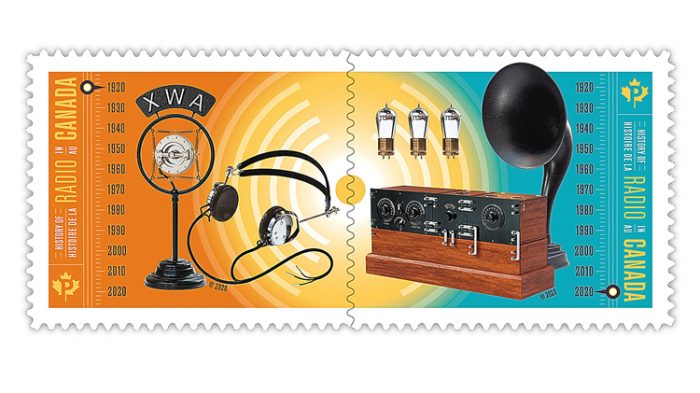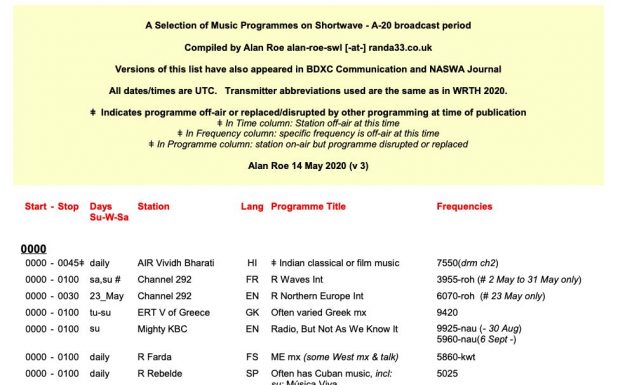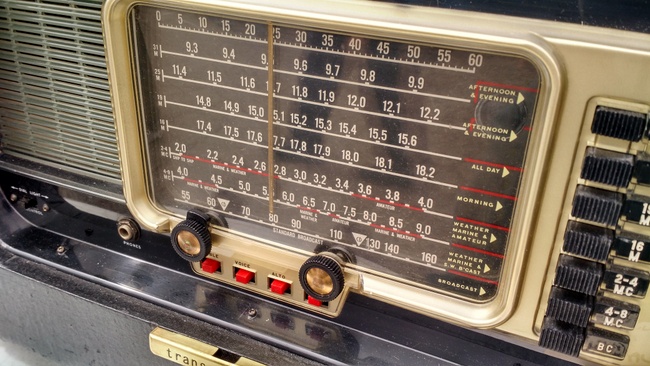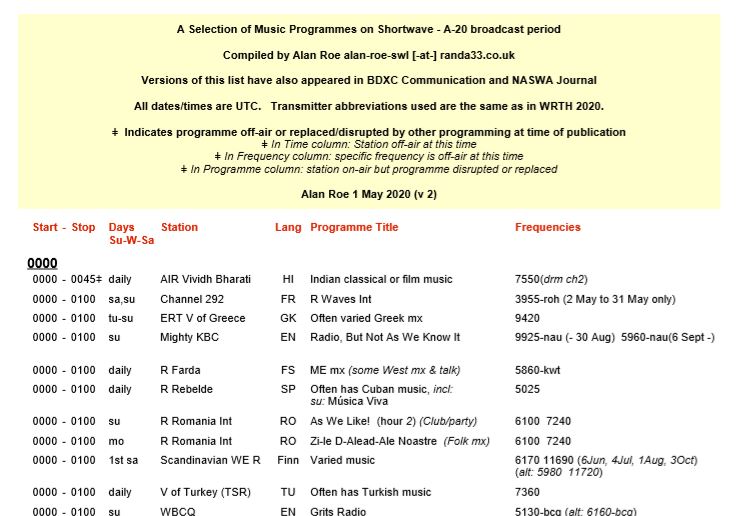Radio Waves: Stories Making Waves in the World of Radio
Because I keep my ear to the waves, as well as receive many tips from others who do the same, I find myself privy to radio-related stories that might interest SWLing Post readers. To that end: Welcome to the SWLing Post’s Radio Waves, a collection of links to interesting stories making waves in the world of radio. Enjoy!
Many thanks to SWLing Post contributors Richard Langley, Charlie Liberto, and Mike Terry for the following tips:
History of Radio in Canada stamps available May 20 (Linn’s Stamp News)
On May 20, Canada Post is issuing a se-tenant (side-by-side) pair of nondenominated permanent-rate (currently 92¢) History of Radio in Canada stamps. The new issue comes in a self-adhesive booklet of 10.
The stamps commemorate Canada’s inaugural radio broadcast, which hit the airwaves a century ago on the evening of May 20, 1920. According to Canada Post’s Details magazine for collectors, the radio program came from Marconi Wireless Telegraph Company’s studios in Montreal, Quebec, and was a closed broadcast for a Royal Society of Canada gathering at the Chateau Laurier hotel in Ottawa, Ontario.
The show featured a live performance by soprano Dorothy Lutton.
“As reported in the Ottawa Journal by one of the journalists invited to listen in, when ‘the latest one-step’ was played, the clarity was so impressive that several of the newspaper writers began to dance,” the May Details magazine said.
The stamp designs list the 10 decades of radio from 1920 to 2020 on the outside edges.[…]
A New PBS Documentary Series about Pan American Airways (Pan Am Historical Foundation)
When the China Clipper took off for the first scheduled flight to Manila on November 22, 1935, it riveted the attention of people around the world. At that moment Pan Am vaulted to a commanding position and the world changed forever as a result. That’s the story brought to life in “Across the Pacific.” Newly unearthed archival motion pictures, photographs, and original sound recordings as well as stunning graphics, help bring this history back to life. The film by Moreno/Lyons Productions tells the epic story of how Pan American Airways became the first to bridge the mighty Pacific – the first airline to cross any ocean. Focusing in particular on the contributions of Pan Am’s visionary leader Juan Trippe, aircraft designer Igor Sikorsky, and radio engineer Hugo Leuteritz, the three-part program will be broadcast on public television, beginning May 18th, 2020.[…]
Charlie notes that this documentary series will feature radio as seen in the following trailer:
Zoom satellite talk now on YouTube (Southgate ARC)
A video of the talk on amateur radio satellites, EME, Meteor scatter and the International Space Station by Robin Moseley G1MHU given via Zoom on Wednesday, May 13 is now available on YouTube
Watch G1MHU talk on satellites
https://www.youtube.com/watch?v=MKjCXepCK_s
The talk was organised by the Denby Dale Amateur Radio Society, their next talk on Zoom will be by the Editor of Practical Wireless, Don Field G3XTT, at 7:30pm BST on Wednesday, May 20, Zoom meeting ID 278 609 9353
AMSAT-UK https://amsat-uk.org/
BBC Radio 6 Music breaks its audience record as UK’s biggest digital-only station (BBC Media Centre)
BBC Radio 6 Music reached a record 2.56 million listeners (from 2.49m last quarter and 2.52m last year), with the station’s weekday breakfast show with Lauren Laverne also seeing its biggest audience ever with 1.3 million listeners, according to the latest Rajars.
The figures released today covering the first quarter of 2020 also reveal that BBC Radio 1’s Breakfast show with Greg James gained 343,000 young 10+ listeners on previous quarter, and BBC Asian Network saw a boost in its audiences.Figures released earlier this week for the same three months show the audience on BBC Sounds is growing, with a record 3.5 million weekly users in March. The total number of plays of live and on-demand content on BBC Sounds between January and March was 275 million, up 25 million on the previous quarter, and there was a record 123 million plays of on-demand radio programmes and podcasts.
James Purnell, Director of BBC Radio and Education, says: “It’s wonderful that listeners have granted BBC Radio 6 Music the top spot as the UK’s biggest digital only station by tuning in in record numbers. It’s no surprise that the station’s brilliant presenters and talented teams are proving a winning formula with their love and passion for music.
“We’ve been holding on to our younger audiences with more than 13 million 15-44 year olds listening to our stations every week whilst competition for their time has continued to intensify. And with more than a quarter of the population now listening to live radio online every week, it shows what an important role BBC Sounds plays for our stations and for our audiences, with record numbers of both live and on-demand plays in the first three months of the year.”
Overall, BBC Radio had 33.54 million listeners and a share of 49.7% (from 33.58m/51% in last quarter and 34.44/51.4% last year).
BBC Radio 1 posted a reach of 9.81 million listeners aged 10+ (from 9.72m last quarter and 10.18m last year). There were 8.92 million 15+ listeners (from 8.79m last quarter and 9.30m last year). The Radio 1 Breakfast Show now attracts 5.47 million listeners 10+ (Mon-Thu), from 5.13m last quarter and 5.44m last year. This quarter saw 4.87 million 15+ listeners (Mon-Thu), compared to 4.81m last quarter and 5.04m last year.
BBC Radio 2’s weekly audience was 14.36 million (from 14.44m last quarter and 15.36m last year). The Zoe Ball Breakfast Show attracted 8.11 million listeners per week, compared to 8.24m last quarter and 9.05m last year.
BBC Radio 3’s audience was 1.98 million (compared with 2.13m last quarter and 2.04m last year).
BBC Radio 4 posted a weekly reach of 10.76 million during the quarter (10.98m last quarter and 11.01m last year). The Today programme (Mon-Sat) has 7.12 million listeners each week, from 7.37m last quarter and 7.32m last year.
BBC Radio 5 Live posted a reach of 5.22 million listeners (5.41m last quarter and 5.40m last year).
Amongst digital-only stations, BBC Radio 1Xtra had a reach of 1.05m weekly listeners 10+ from 1.06m last quarter and 1.13m last year (986,000 weekly listeners 15+ from 987,000 last quarter and 1.05m last year). BBC Radio 4 Extra attracted 1.98 million listeners per week (from 2.27m last quarter and 2.24m last year). BBC Radio 5 Live Sports Extra attracted 601,000 listeners per week (from 914,000m last quarter and 708,000 last year).
BBC Asian Network drew 543,000 listeners, compared to 519,000 listeners last quarter and 536,000 last year.
The BBC World Service posted a weekly UK audience of 1.35 million (from 1.38m last quarter and 1.48m last year). BBC local radio reached 7.8 million listeners per week, from 7.5m last quarter and 7.86m last year.[…]
Do you enjoy the SWLing Post?
Please consider supporting us via Patreon or our Coffee Fund!
Your support makes articles like this one possible. Thank you!











